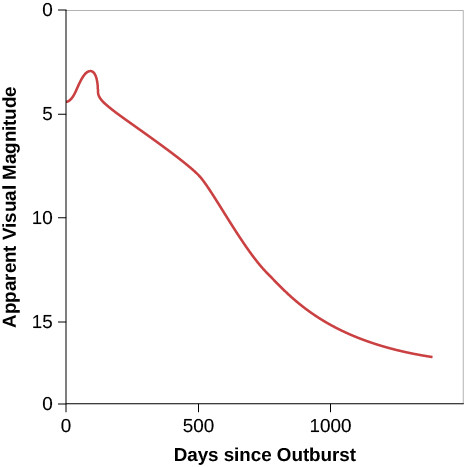| << Chapter < Page | Chapter >> Page > |
Some key stages of evolution of the star that became SN 1987A, including the ones following helium exhaustion, are listed in [link] . While we don’t expect you to remember these numbers, note the patterns in the table: each stage of evolution happens more quickly than the preceding one, the temperature and pressure in the core increase, and progressively heavier elements are the source of fusion energy. Once iron was created, the collapse began. It was a catastrophic collapse, lasting only a few tenths of a second; the speed of infall in the outer portion of the iron core reached 70,000 kilometers per second, about one-fourth the speed of light.
| Evolution of the Star That Exploded as SN 1987A | |||
|---|---|---|---|
| Phase | Central Temperature (K) | Central Density (g/cm 3 ) | Time Spent in This Phase |
| Hydrogen fusion | 40 × 10 6 | 5 | 8 × 10 6 years |
| Helium fusion | 190 × 10 6 | 970 | 10 6 years |
| Carbon fusion | 870 × 10 6 | 170,000 | 2000 years |
| Neon fusion | 1.6 × 10 9 | 3.0 × 10 6 | 6 months |
| Oxygen fusion | 2.0 × 10 9 | 5.6 × 10 6 | 1 year |
| Silicon fusion | 3.3 × 10 9 | 4.3 × 10 7 | Days |
| Core collapse | 200 × 10 9 | 2 × 10 14 | Tenths of a second |
In the meantime, as the core was experiencing its last catastrophe, the outer shells of neon, oxygen, carbon, helium, and hydrogen in the star did not yet know about the collapse. Information about the physical movement of different layers travels through a star at the speed of sound and cannot reach the surface in the few tenths of a second required for the core collapse to occur. Thus, the surface layers of our star hung briefly suspended, much like a cartoon character who dashes off the edge of a cliff and hangs momentarily in space before realizing that he is no longer held up by anything.
The collapse of the core continued until the densities rose to several times that of an atomic nucleus. The resistance to further collapse then became so great that the core rebounded. Infalling material ran into the “brick wall” of the rebounding core and was thrown outward with a great shock wave. Neutrinos poured out of the core, helping the shock wave blow the star apart. The shock reached the surface of the star a few hours later, and the star began to brighten into the supernova Ian Shelton observed in 1987.
The variations in the brightness of SN 1987A in the days and months after its discovery, which are shown in [link] , helped confirm our ideas about heavy element production. In a single day, the star soared in brightness by a factor of about 1000 and became just visible without a telescope. The star then continued to increase slowly in brightness until it was about the same apparent magnitude as the stars in the Little Dipper. Up until about day 40 after the outburst, the energy being radiated away was produced by the explosion itself. But then SN 1987A did not continue to fade away, as we might have expected the light from the explosion to do. Instead, SN 1987A remained bright as energy from newly created radioactive elements came into play.


Notification Switch
Would you like to follow the 'Astronomy' conversation and receive update notifications?